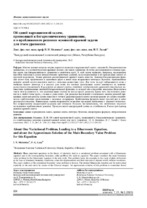Об одной вариационной задаче, приводящей к бигармоническому уравнению, и о приближенном решении основной краевой задачи для этого уравнения

Date
2022Publisher
Another Title
About One Variational Problem, Leading to а Biharmonic Equation, and about the Approximate Solution of the Main Boundary Value Problem for this Equation
Bibliographic entry
Мелешко, И. Н. Об одной вариационной задаче, приводящей к бигармоническому уравнению, и о приближенном решении основной краевой задачи для этого уравнения = About One Variational Problem, Leading to а Biharmonic Equation, and about the Approximate Solution of the Main Boundary Value Problem for this Equation / И. Н. Мелешко, П. Г. Ласый // Наука и техника. – 2022. – № 3. – С. 236-241.
Abstract
Многие важные вопросы теории упругости приводят к вариационной задаче, связанной с бигармоническим уравнением, и к соответствующим краевым задачам для такого уравнения. В статье рассматривается основная краевая задача для бигармонического уравнения в единичном круге. К этой задаче приводит, например, исследование прогибов пластины в случае кинематических граничных условий, когда перемещения и их производные зависят от круговой координаты. Точное решение рассматриваемой краевой задачи известно. Искомая бигармоническая функция может быть представлена в единичном круге в явном виде посредством интеграла Пуассона. Приближенное решение данной задачи находится иногда с помощью разностных схем. Для этого на круг набрасывается сетка с ячейками малого диаметра и в каждом узле сетки все частные производные задачи заменяются их конечно-разностными отношениями. В результате возникает система линейных алгебраических уравнений относительно неизвестных приближенных значений бигармонической функции, из которой они однозначно находятся. Недостатком такого метода является то, что указанная выше система не всегда просто решается. Кроме того, мы получаем решение не в любой точке круга, а только в узлах сетки. Для реальных вычислений и численного анализа решений прикладных задач авторами на основе известного точного решения краевой задачи сконструировано его единое аналитическое приближенное представление с помощью логарифмов. Приближенная формула имеет простой вид и легко реализуется численно. Равномерные оценки погрешности позволяют проводить вычисления с заданной точностью. Все коэффициенты квадратурной формулы для интеграла Пуассона неотрицательны, что значительно упрощает исследование приближенного решения. Проведен анализ квадратурной суммы на устойчивость. Рассмотрен пример решения краевой задачи.
Abstract in another language
Many important questions in the theory of elasticity lead to a variational problem associated with a biharmonic equation and to the corresponding boundary value problems for such an equation. The paper considers the main boundary value problem for the biharmonic equation in the unit circle. This problem leads, for example, to the study of plate deflections in the case of kinematic boundary conditions, when the displacements and their derivatives depend on the circular coordinate. The exact solution of the considered boundary value problem is known. The desired biharmonic function can be represented explicitly in the unit circle by means of the Poisson integral. An approximate solution of this problem is sometimes found using difference schemes. To do this, a grid with cells of small diameter is thrown onto the circle, and at each grid node all partial derivatives of the problem are replaced by their finite-difference relations. As a result, a system of linear algebraic equations arises for unknown approximate values of the biharmonic function, from which they are uniquely found. The disad-vantage of this method is that the above system is not always easy to solve. In addition, we get the solution not at any point of the circle, but only at the nodes of the grid. For real calculations and numerical analysis of solutions to applied problems, the authors have constructed its unified analytical approximate representation on the basis of the known exact solution of the boundary value problem while using logarithms. The approximate formula has a simple form and can be easily implemented numerically. Uniform error estimates make it possible to perform calculations with a given accuracy. All coefficients of the quadrature formula for the Poisson integral are non-negative, which greatly simplifies the study of the approximate solution. An analysis of the quadrature sum for stability is carried out. An example of solving a boundary value problem is considered.
View/
Collections
- № 3[11]
